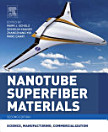Nanotube Superfiber Materials: Changing Engineering Design
About this ebook
Ratings and reviews
- Flag inappropriate
About the author
Mark J. Schulz is a Professor of Mechanical and Materials Engineering at the University of Cincinnati, and Co-director of the Nanoworld Laboratories at the University of Cincinnati. The strategic goal of the Nanoworld Labs is to solve societally important and complex problems, to integrate nanotech into university-wide curricula, to interest students to go to graduate school, and to develop new smart and nano materials and devices for engineering and medical use. Mark is a co-founder of two companies based on university technologies.
Vesselin Shanov is a Professor of Chemical and Materials Engineering at the University of Cincinnati. He has received several prestigious awards including the Fulbright Award for Research and Teaching in the USA, and German Academic Foundation (DAAD) Grants. His recent research focuses on synthesis, characterization and processing of carbon nanotubes and graphene, with applications in the areas of energy storage, electronics and aerospace. He is a member of the Materials Research Society and co-founder and co-director of the teaching and research facility NANOWORLD Labs at the University of Cincinnati. Dr. Shanov has more than 300 scientific publications, including 16 patents, 12 provisional patents and 5 books, has been cited in about 3,100 different references.
Zhangzhang (John) Yin is a Lead Chemist at Ecolab Inc. Previously he worked as the program manager at the NSF Engineering Research Center for Revolutionizing Metallic Biomaterials and Lab Manager in the Nanoworld Lab at the University of Cincinnati. Dr. Yin’s research interest includes corrosion, application of nanotechnology in medicine and water treatment. Dr. Yin received his B.S. from Tongji University and Ph.D. from the University of Cincinnati in Materials Engineering.





